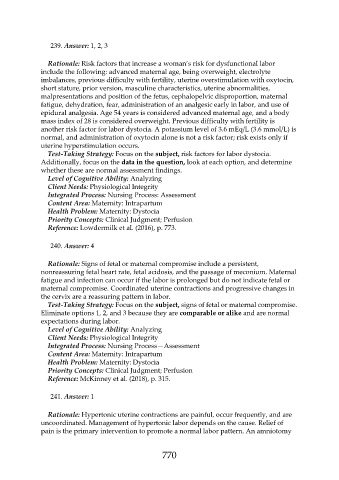Page 770 - Saunders Comprehensive Review For NCLEX-RN
P. 770
239. Answer: 1, 2, 3
Rationale: Risk factors that increase a woman’s risk for dysfunctional labor
include the following: advanced maternal age, being overweight, electrolyte
imbalances, previous difficulty with fertility, uterine overstimulation with oxytocin,
short stature, prior version, masculine characteristics, uterine abnormalities,
malpresentations and position of the fetus, cephalopelvic disproportion, maternal
fatigue, dehydration, fear, administration of an analgesic early in labor, and use of
epidural analgesia. Age 54 years is considered advanced maternal age, and a body
mass index of 28 is considered overweight. Previous difficulty with fertility is
another risk factor for labor dystocia. A potassium level of 3.6 mEq/L (3.6 mmol/L) is
normal, and administration of oxytocin alone is not a risk factor; risk exists only if
uterine hyperstimulation occurs.
Test-Taking Strategy: Focus on the subject, risk factors for labor dystocia.
Additionally, focus on the data in the question, look at each option, and determine
whether these are normal assessment findings.
Level of Cognitive Ability: Analyzing
Client Needs: Physiological Integrity
Integrated Process: Nursing Process: Assessment
Content Area: Maternity: Intrapartum
Health Problem: Maternity: Dystocia
Priority Concepts: Clinical Judgment; Perfusion
Reference: Lowdermilk et al. (2016), p. 773.
240. Answer: 4
Rationale: Signs of fetal or maternal compromise include a persistent,
nonreassuring fetal heart rate, fetal acidosis, and the passage of meconium. Maternal
fatigue and infection can occur if the labor is prolonged but do not indicate fetal or
maternal compromise. Coordinated uterine contractions and progressive changes in
the cervix are a reassuring pattern in labor.
Test-Taking Strategy: Focus on the subject, signs of fetal or maternal compromise.
Eliminate options 1, 2, and 3 because they are comparable or alike and are normal
expectations during labor.
Level of Cognitive Ability: Analyzing
Client Needs: Physiological Integrity
Integrated Process: Nursing Process—Assessment
Content Area: Maternity: Intrapartum
Health Problem: Maternity: Dystocia
Priority Concepts: Clinical Judgment; Perfusion
Reference: McKinney et al. (2018), p. 315.
241. Answer: 1
Rationale: Hypertonic uterine contractions are painful, occur frequently, and are
uncoordinated. Management of hypertonic labor depends on the cause. Relief of
pain is the primary intervention to promote a normal labor pattern. An amniotomy
770

